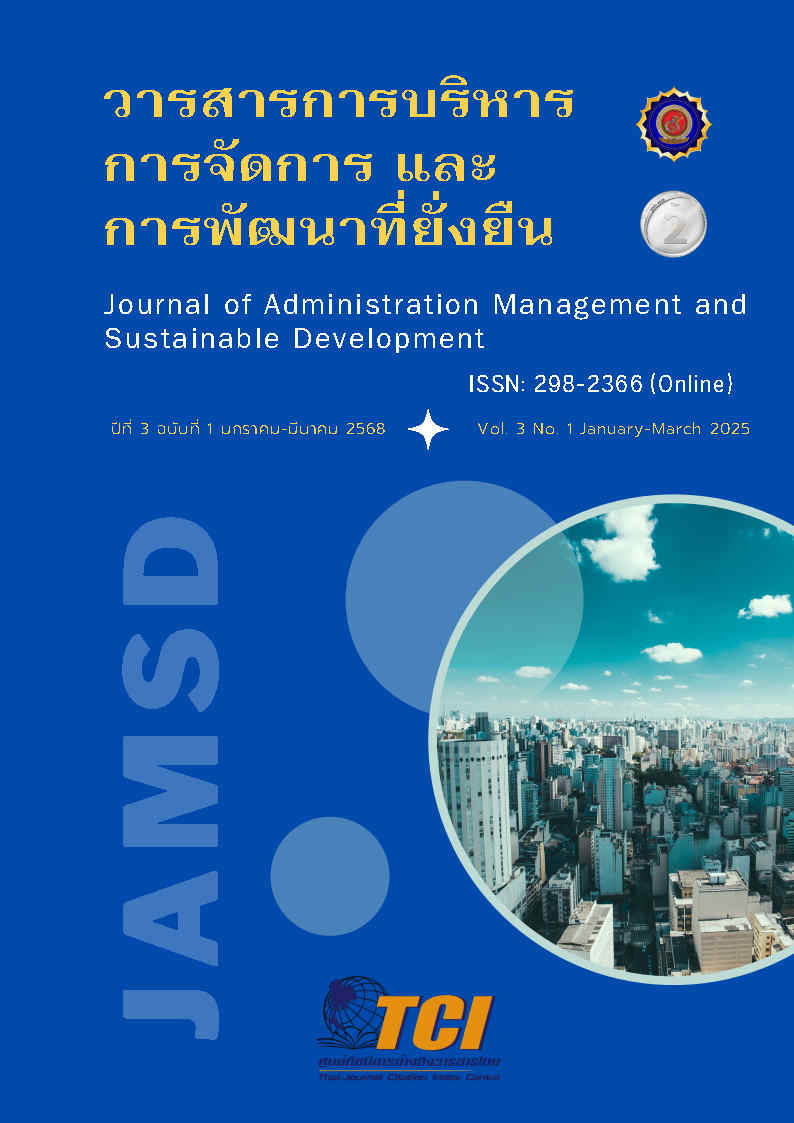Strategic Leadership of Administrators of Nong Han Educational Institutions Group 2 under the Udon Thani Primary Educational Service Area Office 3
Keywords:
strategic leadership, administrator, development guidelineAbstract
The objectives of this research were to study the level and development guidelines of strategic leadership of school administrators in Nong Han 2 Group under Udon Thani Primary Educational Service Area Office 3. Sample group is 102 teachers as informants. The research instruments were questionnaires and interviews, with validity between 0.67-1.00 and reliability of 0.93. Data was collected using google forms. Data analysis employed frequency, percentage, mean, standard deviation, and content analysis. Research findings: 1. The level of strategic leadership of school administrators was overall at a high level, with low dispersion. The aspect with the highest average was goal setting, followed by direction setting and strategy formulation based on vision and objectives. The aspect with the lowest average was strategy implementation and execution. 2.The development guidelines for strategic leadership is Administrators should promote staff participation through regular meetings to listen to opinions, encourage free expression of ideas, assess organizational strengths and potential to create a flexible vision, use technology and data systems for analysis and decision-making, organize training and send staff to external conferences, develop individual development plans, establish mentoring systems, link skill development to career advancement, set up suggestion boxes and committees to gather feedback, and communicate evaluation results to stakeholders through various channels.
References
ฏิมากร บุ้นกี้. (2563). การศึกษาบทบาทภาวะผู้นำเชิงกลยุทธ์ของผู้บริหารสถานศึกษา สังกัดสำนักงานเขตพื้นที่การศึกษาประถมศึกษาตราด. วิทยานิพนธ์ครุศาสตรมหาบัณฑิต สาขาวิชาการบริหารการศึกษา มหาวิทยาลัยราชภัฏรำไพพรรณี.
บุญชม ศรีสะอาด. (2560). การวิจัยเบื้องต้น. (พิมพ์ครั้งที่ 10). กรุงเทพฯ: สุวีริยาสาส์น
สำนักงานเขตพื้นที่การศึกษาประถมศึกษาอุดรธานี เขต 3. (2565). แผนปฎิบัติการประจำปี พ.ศ. 2566. อุดรธานี: กลุ่มงานนโยบายและแผน สำนักงานเขตพื้นที่การศึกษาประถมศึกษาอุดรธานี เขต 3.
สมคิด นาคขวัญ. (2561). ทักษะการบริหารงานในศตวรรษที่ 21 ของผู้บริหารสถานศึกษาตามการรับรู้ของครูสังกัดสำนักงานเขตพื้นที่การศึกษาประถมศึกษาสุราษฎร์ธานี เขต 2. วิทยานิพนธ์ครุศาสตรมหาบัณฑิต มหาวิทยาลัยราชภัฎสุราษฎร์ธานี.
สุนิสา ตั้งตระกูล. (2560). การศึกษาบทบาทภาวะผู้นำเชิงกลยุทธ์ของผู้บริหารสถานศึกษาขั้นพื้นฐานในจังหวัดจันทบุรี ระยอง และตราด. วิทยานิพนธ์ครุศาสตรมหาบัณฑิต สาขาวิชาการบริหารการศึกษา มหาวิทยาลัยราชภัฎรำไพพรรณี.
อดิพงษ์ ผะเดียงฉันท์ และนันทิยา น้อยจันทร์ (2565). ภาวะผู้นําเชิงกลยุทธ์ของผู้บริหารสถานศึกษาสังกัดสำนักงานเขตพื้นที่การศึกษามัธยมศึกษากรุงเทพมหานคร เขต 2. Journal of Roi Kaensarn Academi, 7(5), 305–321.
อภิชญา จะเรียมพันธ์. (2562). ภาวะผู้นำเชิงกลยุทธ์ของผู้บริหารโรงเรียนประถมศึกษา สังกัดสำนักงานเขตพื้นที่การศึกษาประถมศึกษาสมุทรสาคร. การศึกษาอิสระศึกษาศาสตรมหาบัณฑิต สาขาวิชาการบริหารการศึกษา. มหาวิทยาลัยศิลปากร.
Barney, J. (1991). Firm resources and sustained competitive advantage. Journal of Management, 17(1), 99-120.
Blake, R. R., & Mouton, J. S. (1964). The managerial grid: The key to excellence in production and people. Texas: Gulf Publishing Company.
Burns, J. M. (1978). Leadership. New York: Harper & Row.
Carlyle, T. (1841). On Heroes, Hero-Worship, and the Heroic in History. London: James Fraser. Chapman and Hall.
Eisenhardt, K. M., & Martin, J. A. (2000). Dynamic Capabilities: What Are They?. Strategic Management Journal, 21(10/11), 1105-1121.
Fiedler, F. E. (1967). A theory of leadership effectiveness. New York: McGraw-Hill.
Grant, R. M. (2010). Contemporary Strategy Analysis and Cases: Text and Cases. New Jersey: John Wiley & Sons.
Hambrick, D. C., & Fredrickson, J. W. (2001). Are you sure you have a strategy?. The Academy of Management Executive, 15(4), 48-59.
Hamel, G., & Prahalad, C. K. (1994). Competing for the future. Harvard Business Press.
Hersey, P., & Blanchard, K. H. (1969). Life cycle theory of leadership. Training & Development Journal, 23(5), 26-34.
Krejcie, R. V., & Morgan, D. W. (1970). Determining sample size for research activities. Educational and Psychological Measurement, 30 (3), 607 - 610.
Lewin, K., Lippitt, R., & White, R. K. (1939). Patterns of aggressive behavior in experimentally created “social climates”. The Journal of Social Psychology, 10(2), 271-299.
Northouse, P. G. (2018). Leadership: Theory and practice (8th ed.). Sage publications.
Porter, M. E. (1985). Competitive advantage: Creating and sustaining superior performance. New York: The Free Press.
Senge, P. M. (1990). The fifth discipline: The art & practice of the learning organization. New York: Doubleday/Currency.
Stogdill, R. M. (1974). Handbook of leadership: A survey of theory and research. New York: The Free Press.
Thompson, A. A., Strickland, A. J., & Gamble, J. E. (2007). Crafting and Executing Strategy: The Quest for Competitive Advantage: Concepts and Cases (15th ed.). New York: McGraw-Hill Irwin.





